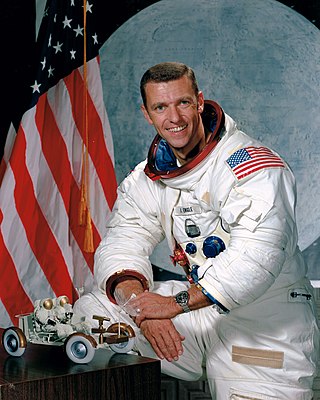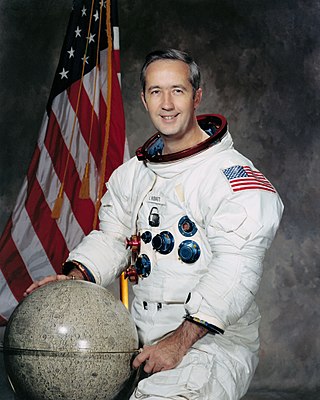
The North American X-15 is a hypersonic rocket-powered aircraft operated by the United States Air Force and the National Aeronautics and Space Administration as part of the X-plane series of experimental aircraft. The X-15 set speed and altitude records in the 1960s, crossing the edge of outer space and returning with valuable data used in aircraft and spacecraft design. The X-15's highest speed, 4,520 miles per hour, was achieved on 3 October 1967, when William J. Knight flew at Mach 6.7 at an altitude of 102,100 feet (31,120 m), or 19.34 miles. This set the official world record for the highest speed ever recorded by a crewed, powered aircraft, which remains unbroken.

Joe Henry Engle is an American pilot, aeronautical engineer and former NASA astronaut. He was the commander of two Space Shuttle missions including STS-2 in 1981, the program's second orbital flight. He also flew three flights in the Shuttle program's 1977 Approach and Landing Tests. Engle is one of twelve pilots who flew the North American X-15, an experimental spaceplane jointly operated by the Air Force and NASA.

Charles Gordon Fullerton was a United States Air Force colonel, a USAF and NASA astronaut, and a research pilot at NASA's Dryden Flight Research Facility, Edwards, California. His assignments included a variety of flight research and support activities piloting NASA's B-52 launch aircraft, the Boeing 747 Shuttle Carrier Aircraft (SCA), and other multi-engine and high performance aircraft.

Robert Donald Cabana is the Associate Administrator of the National Aeronautics and Space Administration (NASA), a NASA astronaut, and a veteran of four Space Shuttle flights. He served as Chief of the Astronaut Office from 1994 to 1997 and as director of the John F. Kennedy Space Center from 2008 to 2021. He is also a former naval flight officer and naval aviator in the United States Marine Corps.

Steven Wayne Lindsey is a retired U.S. Air Force officer and NASA astronaut. Lindsey served as Chief of the NASA Astronaut Office from September 2006 until October 2009.

James Alton McDivitt was an American test pilot, United States Air Force (USAF) pilot, aeronautical engineer, and NASA astronaut in the Gemini and Apollo programs. He joined the USAF in 1951 and flew 145 combat missions in the Korean War. In 1959, after graduating first in his class with a Bachelor of Science degree in Aeronautical Engineering from the University of Michigan through the U.S. Air Force Institute of Technology (AFIT) program, he qualified as a test pilot at the Air Force Experimental Flight Test Pilot School and Aerospace Research Pilot School, and joined the Manned Spacecraft Operations Branch. By September 1962, McDivitt had logged over 2,500 flight hours, of which more than 2,000 hours were in jet aircraft. This included flying as a chase pilot for Robert M. White's North American X-15 flight on July 17, 1962, in which White reached an altitude of 59.5 miles (95.8 km) and became the first X-15 pilot to be awarded Astronaut Wings.

The United States Astronaut Badge is a badge of the United States, awarded to military and civilian personnel who have completed training and performed a successful spaceflight. A variation of the astronaut badge is also issued to civilians who are employed with the National Aeronautics and Space Administration as specialists on spaceflight missions. It is the least-awarded qualification badge of the United States military.

Michael James Adams was an American aviator, aeronautical engineer, and USAF astronaut. He was one of twelve pilots who flew the North American X-15, an experimental spaceplane jointly operated by the Air Force and NASA.

William Harvey Dana was an American aeronautical engineer, U.S. Air Force pilot, NASA test pilot, and astronaut. He was one of twelve pilots who flew the North American X-15, an experimental spaceplane jointly operated by the Air Force and NASA. He was also selected for participation in the X-20 Dyna-Soar program.

Robert Aitken "Bob" Rushworth was an United States Air Force major general, World War II, Korean War and Vietnam War pilot, mechanical and aeronautical engineer, test pilot and astronaut. He was one of twelve pilots who flew the North American X-15, an experimental spaceplane jointly operated by the Air Force and NASA. He flew 34 of the program's 199 flights, more than any other pilot.
Man In Space Soonest (MISS) was a United States Air Force (USAF) program to put a man into outer space before the Soviet Union. The program was cancelled on August 1, 1958, and was replaced by NASA's Project Mercury. Only two men from the program would actually reach outer space. The first, Joseph A. Walker, did so two or three times in X-15 rocket plane tests in 1963. The other, Neil Armstrong, became a NASA astronaut in 1962, flew on Gemini 8 in 1966, and in 1969 on Apollo 11 becoming the first person to walk on the Moon.

Eric Allen Boe is a retired United States Air Force fighter pilot, Colonel, test pilot, and a current, active NASA astronaut. He flew as the pilot of Space Shuttle missions STS-126 and STS-133.

Robert Louis Behnken is an American engineer, a former NASA astronaut, and former Chief of the Astronaut Office.

Michael Scott Hopkins is a United States Space Force colonel and a former NASA astronaut. Hopkins was selected in June 2009 as a member of the NASA Astronaut Group 20. He made his first spaceflight as a Flight Engineer on Soyuz TMA-10M/Expedition 37/Expedition 38, from September 2013 until March 2014. He is the first member of his astronaut class to fly in space. Hopkins is the first astronaut to transfer to the U.S. Space Force, participating in a transfer ceremony on the International Space Station. Prior to his transfer, he served over 27 years in the United States Air Force.

Victor Jerome Glover is a NASA astronaut of the class of 2013 and Pilot on the first operational flight of the SpaceX Crew Dragon to the International Space Station. Glover is a captain and F/A-18 pilot in the U.S. Navy and is a graduate of the U.S. Air Force Test Pilot School. He was a crew member of Expedition 64, and served as a station systems flight engineer.
The John J. Montgomery Award was created by the National Society of Aerospace Professionals (NSAP) and the San Diego Aerospace Museum in 1962 for aerospace achievement. It was awarded from 1962 to at least 1964.

NASA Astronaut Group 22 is a group of twelve NASA astronauts selected in June 2017. They were joined by two Canadian Space Agency astronauts for training.

SpaceX Crew-1 was the first operational crewed flight of a Crew Dragon spacecraft, and the maiden flight of the Crew Dragon Resilience spacecraft. It was also the second crewed orbital flight launch by the United States since that of STS-135 in July 2011. Resilience launched on 16 November 2020 at 00:27:17 UTC on a Falcon 9 from Kennedy Space Center Launch Complex 39A (LC-39A), carrying NASA astronauts Michael Hopkins, Victor Glover and Shannon Walker along with JAXA astronaut Soichi Noguchi, all members of the Expedition 64 crew. The mission was the second overall crewed orbital flight of the Crew Dragon.
















